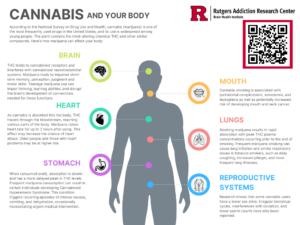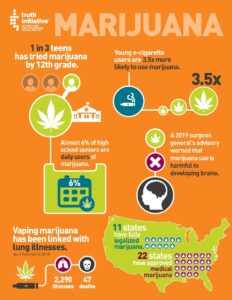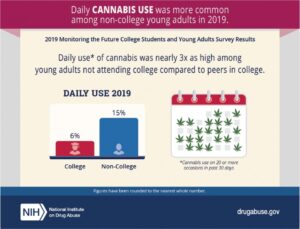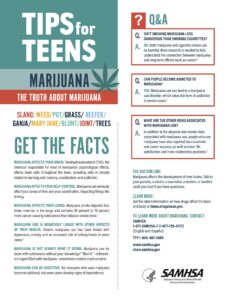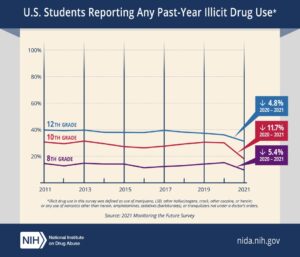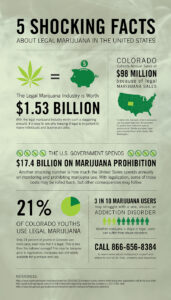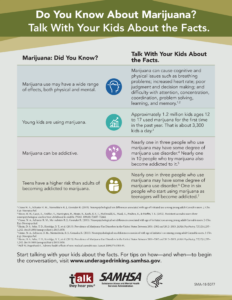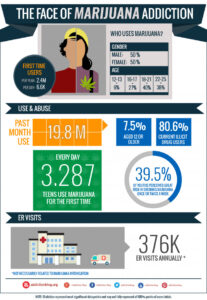Statistics on Cannabis Trends in the United States
Cannabis, which can also be called weed, pot, or dope, is the dried flowers and leaves of the cannabis plant. It contains mind-altering (e.g., psychoactive) compounds like tetrahydrocannabinol, or THC, as well as other active compounds like cannabidiol, or CBD, that are not mind-altering.1
The National Institute for Drug Abuse lists some common effects of cannabis use:
Short-term effects (while using or right after using)
Cannabis overstimulates parts of the brain that contain the highest number of specific brain cell receptors that ordinarily react to natural THC-like chemicals. This produces the sensation of being “high.” Other effects include:
- altered senses (for example, seeing brighter colors)
- altered sense of time
- changes in mood
- impaired body movement
- difficulty with thinking and problem-solving
- impaired memory
- hallucinations (when taken in high doses)
- delusions (when taken in high doses)
- psychosis (risk is highest with regular use of high potency cannabis)
Cannabis also impacts brain development. When people begin using cannabis as teenagers, the drug may hinder cognitive functions like thinking, memory, and learning, and also influence the brain’s ability to build connections between the areas necessary for these functions. Researchers are still investigating the duration of cannabis’ effects and whether or not they may have permanent impacts.
Effects that last longer than the short term (a few days) but may not be permanent
- learning and memory problems
- sleep problems
Long-term effects (effects of repeated use)
- risk of cannabis addiction
- long-term learning and memory problems if heavy use begins during youth
- risk for chronic cough, bronchitis
- risk of schizophrenia in some people with higher genetic risk
- in rare cases, risk of recurrent episodes of severe nausea and vomiting
Other health effects:
Physical Effects
- Breathing problems
- Increased heart rate
- Problems with child development during and after pregnancy
- Intense nausea and vomiting
Mental Effects
- Long-term cannabis use has been linked to mental illness in some people, such as:
- temporary hallucinations
- temporary paranoia
- worsening symptoms in patients with schizophrenia—a severe mental disorder with symptoms such as hallucinations, paranoia, and disorganized thinking
Cannabis usage has also been associated with other mental health conditions, such as depression, anxiety, and suicidal ideation among teens. However, further research is still needed.
Additional facts according to the National Survey on Drug Use and Health:
- In 2021, 35.4% of young adults aged 18 to 25 (11.8 million people) reported using cannabis in the past year.
- In 2022, 30.7% of 12th graders reported using cannabis in the past year and 6.3% reported using cannabis daily.
- In 2022, nearly 20.6% of 12th graders reported that they vaped cannabis in the past year and 2.1% reported that they did so daily.
- According to the Monitoring the Future survey, rates of past year cannabis use among middle and high school students have remained relatively steady since the late 1990s2.
Cannabis is the most commonly used addictive drug after tobacco and alcohol.3 According to the Centers for Disease Control and Prevention, research suggests that 3 in 10 people who use cannabis may have some form of cannabis use disorder, meaning they are unable to stop using cannabis even though it is causing health and social problems in their lives. For people who begin using cannabis before the age of 18 and who use cannabis often (daily/near daily), the risk of developing cannabis use disorder is even greater.
For more information, please visit: https://nida.nih.gov/publications/drugfacts/cannabis-marijuana
1 National Academies of Sciences, Engineering, and Medicine. The health effects of cannabis and cannabinoids: the current state of evidence and recommendations for research. Washington, DC: The National Academies Press; 2017.
2 Miech, R. A., Johnston, L. D., Patrick, M. E., O’Malley, P. M., Bachman, J. G., & Schulenberg J. E. (2023). Monitoring the Future National Survey Results on Drug Use, 1975-2022. Monitoring the Future Monograph Series. Ann Arbor: Institute for Social Research, The University of Michigan.
3Substance Abuse Center for Behavioral Health Statistics and Quality. Results from the 2018 National Survey on Drug Use and Health: Detailed Tables. SAMHSA. https://www.samhsa.gov/data/report/2018-nsduh-detailed-tables. Accessed December 2019.


